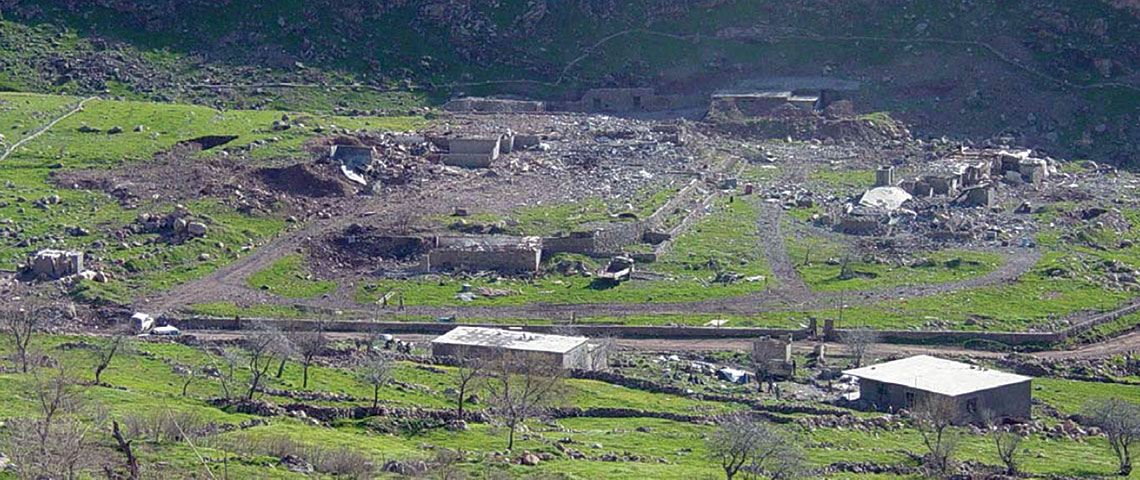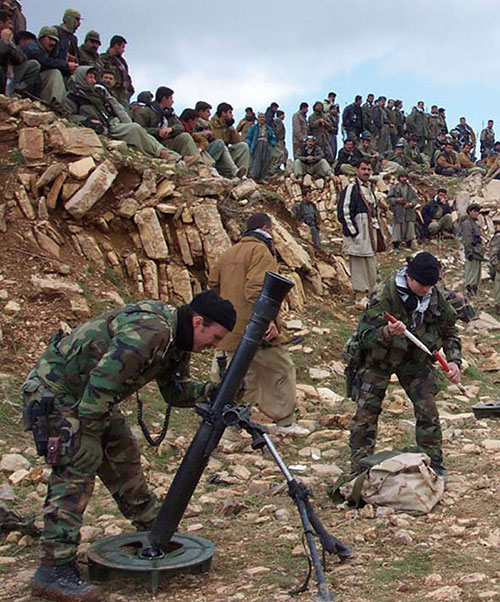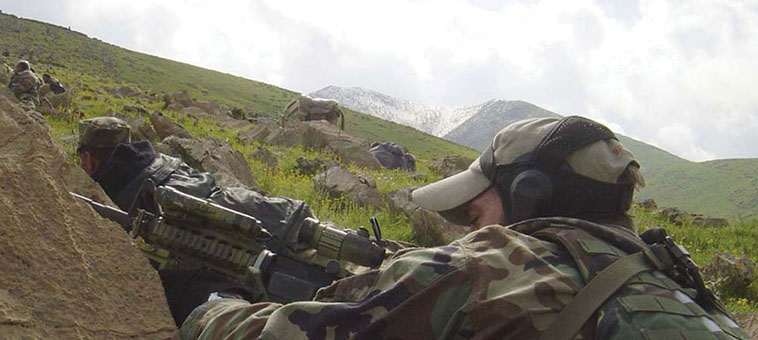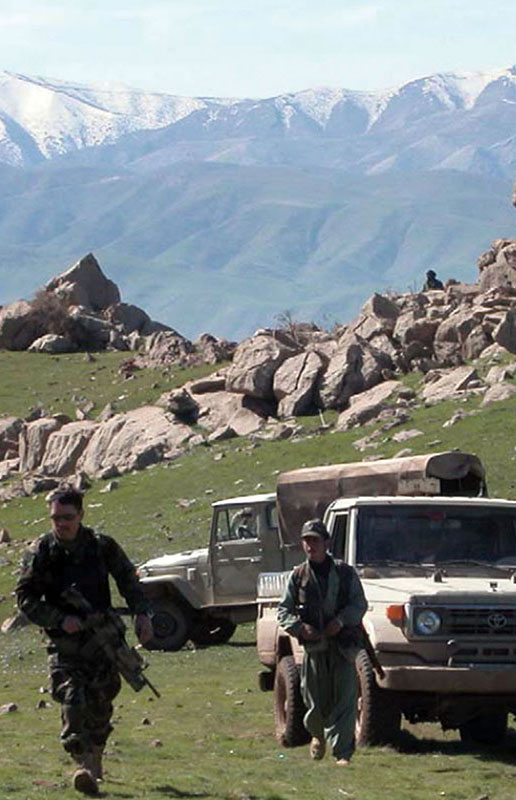DOWNLOAD
In preparing his campaign plan for operations in northern Iraq, Colonel (COL) Charles Cleveland, Commander of 10th Special Forces Group (SFG), faced a two-pronged dilemma. His primary opposition in the region came in the form of three Iraqi Corps—more than 150,000 troops massed along the 140-kilometer political boundary known as the Green Line. To confront this force, Cleveland’s 300 Special Forces (SF) soldiers joined with more than 50,000 Kurdish fighters arrayed against Iraqi forces. Yet, prior to engaging the Iraqi frontline forces, Cleveland determined he needed to eliminate the threat to the Kurdish rear area posed by the Ansar al-Islam terrorist organization.1
Ansar al-Islam (AI) routinely skirmished with the Kurdish troops from its stronghold above the town of Halabjah in the mountainous Khurma region near the Iranian border. With well developed defensive positions on the high ground above the valley, the seven hundred-man-strong AI was a formidable threat to any Kurdish operations against the Green Line. A contingent of Iranian-supported Kurds, the Islamic Group of Kurdistan (IGK), also occupied a sector in the northern portion of the area and would need to be dealt with along with the AI. One final threat, a suspected Weapons of Mass Destruction (WMD) site, was located in the village of Sargat at the foot of the Shandahari Ridge.

10th SFG developed a plan, code named Operation VIKING HAMMER, to deal with the AI. COL Cleveland assigned the mission of reducing the AI threat to 3rd Battalion, which was already fighting Iraqi forces along the Green Line. Reinforced C Company, 3rd Battalion was to counter the AI threat in the east, then rejoin the remainder of 3rd Battalion on the Green Line, where it was fighting alongside 2nd Battalion, 10th SFG; 3rd Battalion, 3rd SFG; and Kurdish forces. Pushing the Iraqi divisions off the Green Line would open the way for the capture of Kirkuk and Mosul, clearing the northern approaches to Baghdad.2
The principal allies in the fight against AI were the 6,500 Peshmerga (“those who face death”) fighters of the Patriotic Union of Kurdistan (PUK), under the ground force command of Kak Mustafa. Mustafa looked to the American Special Forces to provide the firepower and close air support he desired for an attack against AI. Mustafa also realized that having U.S. forces by his side would deter Iran from openly backing AI in battle. Lieutenant Colonel (LTC) Ken Tovo, commander of 3rd Battalion, and Mustafa formulated a six-pronged attack to drive AI out of the valley, and seize the suspected WMD site at Sargat. Before the attack commenced, however, a demonstration of U.S. firepower and resolve was in order.3
In position for the operation, Operational Detachment A (ODA) 081 occupied a small house in Halabjah, looking down the flat valley toward the AI stronghold in the hills above. On the evening of 21 March, LTC Tovo and Kak Mustafa stood on the roof of the house looking up the alley in anticipation of the first missile attack on the AI forces. An anxious twenty-five minutes after the scheduled strike time, the first Tomahawk Land Attack Missile (TLAM) droned overhead and impacted on the AI positions. Every few minutes for the next three hours, another TLAM struck the target. By the end of the bombardment, sixty-four TLAMs had impacted in the region of the AI base of operations, though with minimum effectiveness, since after the first missile the enemy took shelter in their caves. Missiles detonated around the WMD facility at Sargat, and throughout the targeted sector, but did not significantly degrade AI’s defensive positions. However, the TLAM strikes did drive the IGK from their positions, and eliminated the organization as a factor in the battle.4

Though the TLAMs had prepared the battlefield on the 21st, the ground attack was delayed until 3rd Battalion could get more troops on the ground and air support lined up. VIKING HAMMER was built around a six-pronged attack up the valley. From north to south, the assault routes were designated Orange, Black, Green, Yellow, Red, and Blue. Each prong consisted of nine hundred to fifteen hundred Peshmerga fighters, accompanied by members of an SF ODA. In order to command the fight, LTC Tovo colocated Forward Operating Base (FOB) 103 with Major Greg Tsouris’ (pseudonym) Advanced Operating Base (AOB) 090 on Hill 654, where they could see almost the entire valley. Members of AOB 090 also manned 81mm mortars in support of Green and Red routes, with supplemental targets on Blue route.5
At 0600 on 28 March, the attack commenced. The Yellow prong aimed for the devastated WMD site at Sargat, and the flanking routes targeted the AI on the succession of hills and ridges around the site. The speed of the Peshmerga attack resulted in rapid advance on all the routes. “The Pesh generally looked for a weak point, attacked it with all their weapons, then bum rushed the target,” is the description of PUK tactics given by Sergeant First Class Mark Greenlaw (pseudonym), in charge of the three-gun 81mm mortar section supporting Yellow route.6 The Kurdish fighters’ pace made it difficult for the mortar section to follow the frontline trace. Coupled with the reluctance of the Peshmerga to allow supporting fires close to their own troops, the speed required Greenlaw and his crew to frequently halt in order pinpoint the targets.7 Due to the onrush of the Peshmerga up the valley, the AI fighters were unable to deliberately retrograde and take advantage of their prepared positions and caches of weapons and equipment.

The combined force made considerable progress along all the assault routes that first day. Troops advancing along routes Red and Blue secured several of the small villages in the valley. Blue prong advanced up the valley and halted for the night at the village of Biyara. As they swept through the valley, SF and Peshmerga soldiers observed the AI fighters fleeing higher up the valley from the Biyara area to more heavily fortified positions on the slopes of Shram Mountain. The swift capture of Hill 868 allowed the troops on the Green route to overwatch the Yellow advance toward Sargat. Yellow prong forces seized the AI checkpoint, cleared a series of caves along the route, and split to send one element against the town of Bahka Kon. The northern element headed to Sargat, which was secured at approximately 1000 hours.8 Troops assigned to route Black served as the reserve force. On the northernmost route, the forces on the Orange prong attacked east from Shilamar to Hill 1351, where they were stopped for the day. The hill supported a communications tower and bunker with approximately twenty AI troops, who withstood three air strikes and kept the PUK from advancing closer than two hundred meters from the bunker.9
Once darkness fell, the PUK troops regrouped and consolidated their positions. Four AC-130 gunships maintained pressure on the scattered AI fighters, and prevented them from regrouping. By morning, the Peshmerga were ready to resume the offensive.10 The attack continued on 29 March with the forces on the Green route advancing northeast and seizing the high ground on Hill 1365. The Yellow route forces pushed out from Sargat and expanded their perimeter to include the villages of Hanidind and Daramar. The forces on Red consolidated their gains in the vicinity of Biyara. The troops on Black, held in reserve the previous day, joined with the Orange prong to conduct a coordinated attack up the Zalm Valley and the northern approaches, where they secured Hill 1351.

Throughout the rest of the day and into the next, the PUK chased AI towards the Iranian border, where many crossed without difficulty, while others were met with fire from the Iranians and forced back toward the Peshmerga.11 By 30 March, the PUK was in control of the formerly AI-dominated valley and held the high ground overwatching the area running towards the Iranian border. VIKING HAMMER had eliminated AI as an effective fighting force, and removed the threat to the PUK rear area. With this accomplished, the mission transitioned to supporting the PUK forces on the Green Line.
The presence of the SF teams helped the Peshmerga in numerous ways, from providing close air support and indirect fire, to assisting with command and control and combined planning before the attack. The SF presence was important in less quantifiable ways, as well. As LTC Tovo remarked, “the morale boost for the PUK of seeing U.S. SF in their ranks cannot be understated. The ODA members attacking with them were tangible proof that the U.S. was committed to providing them assistance.”12 In the weeks that followed the assault, Chemical and Biological Inspection Survey Teams and Document Exploitation Teams were able to examine the secured Sargat site. The PUK spent its time consolidating its hold over the region, and planning for the next stage of their long-awaited fight against Saddam’s regime. With the AI threat gone, 3rd Battalion, SFG and the PUK were free to join the rest of the Kurdish forces in attacking the Iraqis on the Green Line and opening the way for coalition control of the north.
